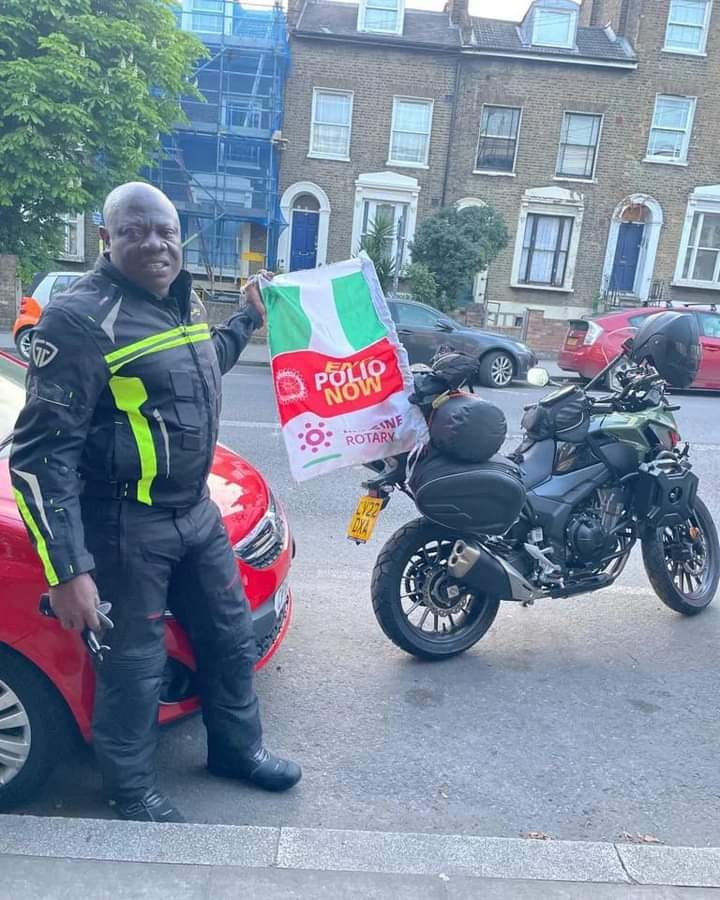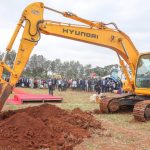While riding across the world has been embraced by many travel fanatics for leisure and adventure, it is a different case for Nigerian motorcycle rider and motivational speaker Kunle Adeyanju.
The 44-year-old said he opted for his die-hard adventure to ride across 13 countries in his journey from London to Lagos to create awareness of polio eradication globally, particularly in Africa.
Polio is a highly infectious viral disease that largely affects children under 5 years of age as its virus invades the nervous system and causes paralysis for life.
Adeyanju takes the matter seriously because has a best friend whose potential in life was limited due to the distressing effects of Polio that eventually led to his death.
As young boys when they were supposed to enjoy activities like swimming and running competitions, he says he was always saddened because his best friend Sanju couldn’t join them as he was tied in a wheelchair.
“When growing up in Elementary School, my best friend had polio. We had all activities that kids do in school but he couldn’t do them because he was limited by Polio. Come 2020, he died not because of Polio but because Polio limited his opportunity in life,” Adeyanju told this writer in an interview in Nairobi.
When Sanju sadly died in 2020, Adeyanju says he found a purpose for his quest to join humanitarian services in efforts to ensure polio eradication, especially in Africa.
Being a Rotarian, by virtue of being a member of the Rotary International he pegged his initiative to not only create awareness but to also raise funds.
“I knew he went through a lot of pain all through the years. When we lost him it was painful and I thought I had the opportunity to actually raise awareness and end Polio globally so that another child elsewhere doesn’t go through the pain he went through,” Adeyanju narrated.
The Nigerian Motorcycle rider took a whole year to build the plan for the journey which he anticipated would take him 14 days to travel for the 13,000 kilometers ride by finding support hotlines in case of danger and settling on the best route.
“I knew that it was going to be a solo ride riding through one of the most inhospitable environments in the world. The only way to come out of it alive was to make sure I had a solid plan,” he said.
On 19th April 2022, Adeyanju started his ride from London and he admits that he did it scared thinking of the treacherous ride ahead of him that later saw him cross oceans and deserts before making it to Lagos, Nigeria.
“So, I left London about 5am in the morning and on the same day I crossed the English cross channel through the ferry. I will not lie that I didn’t fear because I knew at any moment I would die. Accidents could happen but I was a bit confident because of my plan,” he said.
Dangerous Treks
In his initial plan, Adeyanju was ambitious that he would complete the journey within 14 days but it would take him 41 days to complete the trek due to dangerous and hopeless situations that he faced along the expedition.
He narrates that riding across the European Continent was one of the hardest stretches of his journey due to the cold weather. From Girona in Spain to Valencia it rained all through across 1,200 kilometers.
“Even with my five layers of warm clothes, cold was still a problem. I almost had frost bites in my hand because imagine going through the cold wind. By the time I was getting to Valencia, I was terribly shaken,” Adeyanju said.
Riding through Spain, he decided to travel across the Mediterranean Sea pushed by his keen eye for sea adventure but he reveals he almost died due to strong cross winds that blew him off the road.
“That was the first time I thought I was going to die. The cross winds were so strong that they lifted me off the ground and threw me off. I am a religious person, I shouted Jesus and untill today I don’t even know how I got control of the bike,” Adeyanju recalls.
“I just remember parking the bike across the road and my legs were shaking throughout. I couldn’t ride the bike for almost a whole hour,” he added.
From the cold weather in Europe then came the scorching heat and life-threatening sand dunes in the dangerous Sahara Desert.
It took Adeyanju four days to cross the desert considered the deadliest on Earth. This is due to the extreme heat and lack of water that make it a challenging and dangerous place to travel.
“If you push you bike anyhow, you are going to burst the tire and if you blow your tire in the Sahara, you are done. You might fall sick due to the extreme heat and cold which is the weather in the desert,” he said.
Deep inside the desert while in Morocco he came across sand storms that lasted for close to one hour. The sandstorm experience overwhelmed him emotionally, it was a near-death experience. He almost gave up.
“I remember when I cried in the desert when I was hit by sand storms. I noticed the wind was strong and decided to come off the bike but even while sitting on the ground with my 93kgs I felt something lifting me off the ground,”
“It was difficult to breathe as I was lying down holding my bike. When the sand storm was over, something in my mind told me to go back, but I urged myself on,” Adeyanju said.
Humanity in Africa
Adeyanju’s commitment and drive to complete the journey was bolstered during his trek across the African Countries of Morocco, Mauritania, Senegal, Mali, Burkina Faso, Cot D’Ivoire, Ghana, Togo, Benin, and Nigeria.
He says the warm reception he received in different African countries made him resolve to complete the 13,000 kilometers journey.
“Crossing to Africa was a totally different ball game. I never expected it because my research about Africa was painted negative due to criminality and war zones. I discovered completely different things, it was in Africa where I saw humanity,” said Adeyanju.
“In Mali, I ran into one village at night when my bike was involved in an accident and I couldn’t move. I bombarded the village and everyone ran away but the women came back and helped me out despite our language barrier. We talked using sign language before my interpreter came,”
His drive has been transformational in terms of creating awareness that also managed to attract well-wishers to support Polio eradication into the rotary foundation kitty.
“Post the ride the message is quite relevant. I was appointed Polio Ambassador and I was quite involved in awareness and immunization program. People are still contributing money even after ending the ride,”Adeyanju said.
Polio Eradication
Africa has made significant strides in the fight against polio, reaching a monumental achievement in August 2020 when the region was certified as free of indigenous wild polio after eliminating all forms of wild poliovirus.
Wild polio was eradicated in Kenya in 2014 but the country remains at risk of polio due to low immunization coverage resulting from Covid-19 interruptions, porous borders with high-risk countries, and high population movements.
Eradicating polio requires immunizing every child until transmission stops and the world is free of all forms of poliovirus.
Today, the fight continues against all forms of poliovirus. A rare vaccine-derived version of the poliovirus is affecting African countries with low immunization coverage, particularly among remote communities and those experiencing migration or conflict.
“Africa has done a lot but we still have a lot to do. We are in the last mile of eradication and that’s where we really need to re-double our efforts.Because of being certified polio-free people have become complacent and with the virus in the air children are infected,”
“Let’s sustain the immunization process,” Adeyanju said.



